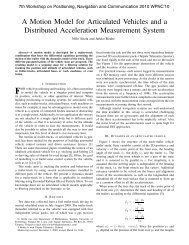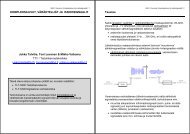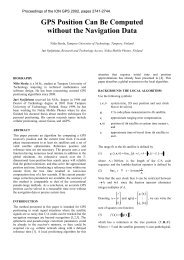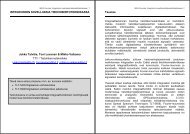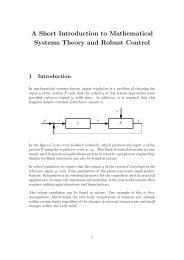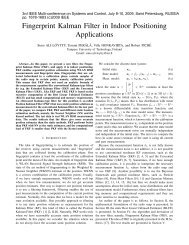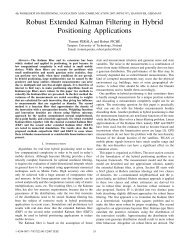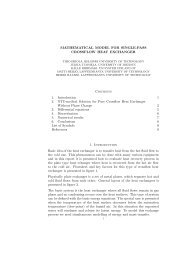Antti Lehtinen Doppler Positioning with GPS - Matematiikan laitos
Antti Lehtinen Doppler Positioning with GPS - Matematiikan laitos
Antti Lehtinen Doppler Positioning with GPS - Matematiikan laitos
You also want an ePaper? Increase the reach of your titles
YUMPU automatically turns print PDFs into web optimized ePapers that Google loves.
the receiver needed to collect measurement data over several minutes. The actual<br />
computation of the receiver position was based on the <strong>Doppler</strong> curve of a satellite<br />
pass. <strong>Doppler</strong> curves of satellites are flatter than in Figure 2.2. This is because<br />
they travel alongcircular orbits rather than straight lines. The position of the<br />
receiver was determined by curve fitting. The latitude and longitude estimates<br />
were optimised such that the computed <strong>Doppler</strong> curve fitted to the measured<br />
data. The computational details can be found in [Laurila, p. 474]. The accuracy<br />
of the Transit system was about half a kilometre.<br />
In order to compute the <strong>Doppler</strong> curves, one also needs to know the position<br />
and velocity vectors of the satellite. Thus, the Transit satellites transmitted<br />
binary data by phase modulation. This data is called ephemeris. One was able<br />
to compute the satellite position and velocity from the ephemeris. The Transit<br />
satellites transmitted continuous wave signals on two distinct frequencies, namely<br />
150 MHz and 400 MHz. The purpose of this was to eliminate the first order<br />
ionospheric refraction and receiver frequency measurement errors. The accuracy<br />
of the Transit system was about 100 meters for a stationary receiver, but was<br />
severely worse for a receiver in unknown motion [Laurila, p. 476]. According<br />
to [Parkinson & Spilker, p. 4], the Transit system is still operational, but new<br />
satellites are not beinglaunched.<br />
6




